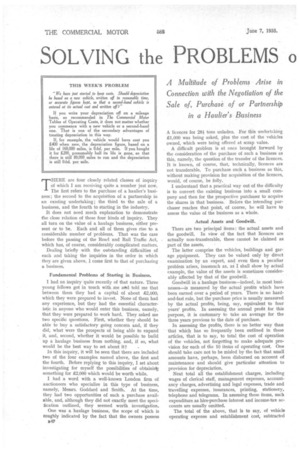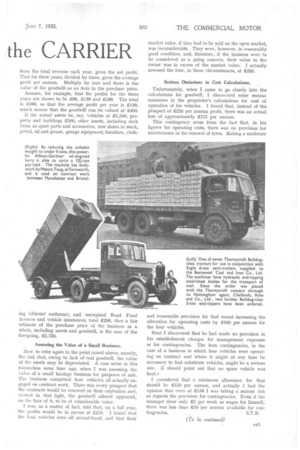SOLVING the PROBLEMS o
Page 56

Page 57

If you've noticed an error in this article please click here to report it so we can fix it.
the CARRIER
A Multitude of Problems Arise in Connection with the Negotiation of the Sale of, Purchase of or Partnership in a Haulier's Business
THERE are four closely related classes of inquiry Of which I am receiving quite a number just now. The first refers to the purchase of a haulier's business; the second to the acquisition of a partnership in an existing undertaking ; the third to the sale of a business, and the fourth to starting in the industry.
It does not need much explanation to demonstrate the close relation of these four kinds of inquiry. They all turn on the value of a haulage business, either present or to be_ Each and all of them gives rise to a considerable number of problems. That was the case before the passing of the Road and Rail Traffic Act, which has, of course, considerably complicated matters. Dealing briefly with the outstanding difficulties of each and taking the inquiries in the order in which they are given above, I come first to that of purchasing a business.
Fundamental Problems of Starting in Business.
I had an inquiry quite recently of that nature. Three young fellows got in touch with me and told me that between them they had a capital of about £2,000, which they were prepared to invest. None of them had any experience, but they had the essential characteristic in anyone who would enter this business, namely, that they were prepared to work hard. They asked me two specific questions. First, whether they should be able to buy a satisfactory going concern and, if they did, what were the prospects of being able to expand it, and, second, whether it would be possible to build up a haulage business from nothing. and, if so, what would be the best way to set about it?
In this inquiry, it will be seen that there are included two of the four examples named above, the first and the fourth. Before replying to this inquiry, I set about investigating for myself the possibilities of obtainintg something for £2,000 which would be worth while.
I had a word with a well-known London firm of auctioneers who specialize in this type of business, namely, Messrs. Goddard and Smith. At the time, they had two opportunities of such a purchase available, and, although they did not exactly meet the specification outlined, they seemed worth investigation.
One was a haulage business, the scope of which is roughly indicated by the fact that the owners possess B42. A licences for 28-4 tons unladen. For this undertaking £1,000 was being asked, plus the cost of the vehicles owned, which were being offered at scrap value.
A difficult problem is at once brought forward by the consideration of the purchase of such a business as this, namely, the question of the transfer of the licences. It is known, of course, that, technically, licences are not transferable. To purchase such a business as this, without making provision for acquisition of the licences, would, of course, be folly.
I understand that a practical way out of the difficulty is to convert the existing business into a small company and then for the prospective purchaser to acquire the shares in that business. Before the intending purchaser reaches that point, of course, he will have to assess the value of the business as a whole.
Actual Assets and Goodwill.
There are two principal items: the actual assets and the goodwill. In view of the fact that licences are actually non-transferable, these cannot be claimed as part of the assets.
The latter comprise the vehicles, buildings and garage equipment. They can be valued only by direct examination by an expert, and even then a peculiar problem arises, inasmuch as, as I shall show by actual example, the value of the assets is sometimes considerably affected by that of the goodwill.
Goodwill in a haulage business—indeed, in most businesses—is measured by the actual profits which have been earned over a period of years. There is no hardand-fast rule, but the purchase price is usually measured by the actual profits, being, say, equivalent to four years' profits. In assessing the annual profit for this purpose, it is customary to take an average for the three years previous to the date of purchase.
In assessing the profits, there is no better way than that which has so frequently been outlined in these articles, that is to say, to total the cost of operation of the vehicles, not forgetting to make adequate provision for each of the 10 items of operating cost. One should take care not to be misled by the fact that small amounts have, perhaps, been disbursed on account of maintenance and should give particular attention to provision for depreciation.
Next total all the establishment charges, including wages of clerical staff, management expenses, accountancy charges, advertising and legal expenses, trade and travelling expenses, insurances, printing, stationery, telephone and telegrams. In assessing these items, such expenditure as hire-purchase interest and income-tax accounts are usually omitted.
The total of the above, that is to say, of vehicle operating expense and establishment cost, subtracted from the total revenue each year, gives the net profit. That for three years, divided by three, gives the average profit per annum. Multiply by four and there is the value of the goodwill as an item in the purchase price.
Assume, for example, that the profits for the three years are shown to be £80, £120 and £160. The total is £360, so that the average profit per year is 2120, which means that the goodwill can be valued at £480.
If the actual assets be, say, vehicles at £1,500, property and buildings 2500, other assets, including such items as spare parts and accessories, new stores in stock, petrol, oil and grease, garage equipment, furniture, cloth ing (drivers' uniforms), and unexpired Road Fund licences and vehicle insurances, total £250, then a fair estimate of the purchase price of the business as a whole, including assets and goodwill, is the sum of the foregoing, £2,730.
Assessing the Value of a Small Business.
Now, to refer again to the point raised above, namely, the risk that, owing to lack of real goodwill, the value of the assets may be depreciated. A case arose in this connection some time ago, when I was assessing the value of a small 'haulage business for purposes of sale. The business comprised four vehicles, all actually engaged on contract work. There was every prospect that the contracts would be renewed on their expiration and, viewed in that light, the goodwill offered appeared, on the face of it, to be of considerable value, I was, as a matter of fact, told that, on a full year, 'the profits would be in excess of £250. I found that the four vehicles were all second-hand, and that their market value, if they had to be sold on the open market, was inconsiderable. They were, however, in reasonably good condition, and, therefore, if the business were to be considered as a going concern, their value to the owner was in excess of the market value. I actually assessed the four, in those circumstances, at £293.
Serious Omissions in Cost Calculations.
Unfortunately, when I came to go closely into the calculations for goodwill, I discovered some serious omissions in the proprietor's calculations for cost of operation of his vehicles. I found that, instead of the prospect of £250 per annum profit, there was an actual loss of approximately £175 per annum.
This contingency arose from the fact that, in his figures for operating costs, there was no provision for maintenance or for renewal of tyres. Making a moderate and reasonable provision for that meant increasing the allocation for operating costs by 2160 per annum for the four vehicles.
Next I discovered that he had made no provision in his establishment charges for management expenses or for contingencies. The item contingencies, in the case of a business in which four vehicles were operating on contract and where it might at any time be necessary to find substitute vehicles, might be a serious one. (I should point out that no spare vehicle was kept.) I considered that a minimum allowance for that should he £150 per annum, and actually I had the opinion that even at £150 I was taking a serious risk as regards the provision for contingencies. Even if the manager drew only £2 per week as wages for himself, there was less than £50 per annum available. for con tingencies. S.T.R.




























































































